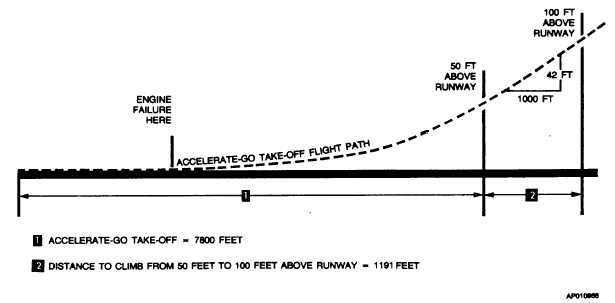TM 55-1510-220-10
7-11. Takeoff Climb Gradient - One Engine
Inoperative (Flaps 0%).
Enter the graph at 280C, 5433 feet pressure altitude,
and 10,000 pounds:
Climb Gradient........................................... 4.2%
Climb Speed .......................................109 knots
A 4.2 climb gradient is 42 feet of vertical height per
1000 feet of horizontal distance.
NOTE
The graphs for takeoff climb
gradient
assume
a
zero-wind
condition. Climbing into a head
wind will result in higher angles
of
climb,
and
hence
better
obstacle clearance capabilities.
Calculations of the horizontal distance to clear an
obstacle 100 feet above the runway surface:
Distance from 50 feet to 100 feet = 50 feet
(100 - 50) (1000 + 42) = 1191 feet
Total Distance = 7800 + 1191 = 8991 feet
Results are illustrated below:
Figure 7-1. Takeoff Flight Path
7-12. FLIGHT PLANNING.
Calculations for flight time, block speed, and fuel
requirements for a proposed flight are detailed below
using the same conditions presented on page 17-1, and
a takeoff weight of 12,000 pounds:
DEN
Pressure Altitude................................. 5433 feet
FAT............................................................ 28°C
ISA Condition ................................... ISA + 23°C
DEN-SLC
Pressure Altitude.............................. 26,000 feet
FAT........................................................... -10°C
ISA Condition ................................... ISA + 27°C
SLC-RNO
Pressure Altitude.............................. 26,000 feet
FAT........................................................... -20°C
ISA Condition ................................... ISA + 17°C
Change 2 7-3

